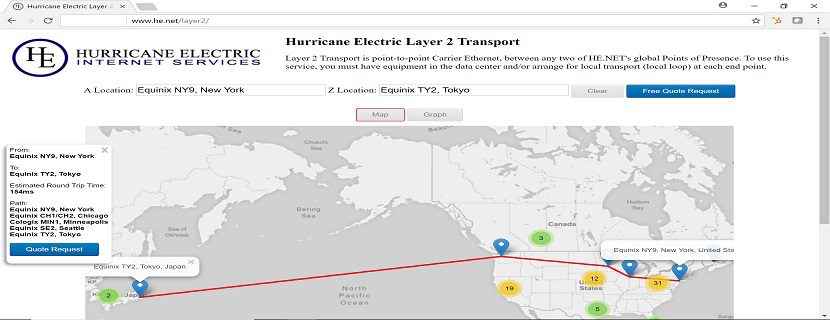Data Center Knowledge recently wrote in-depth on Hurricane Electric’s new Layer 2 Latency Tool. From the article:
Hurricane Electric Shows How Fast and Where Your Data Hops
Christine Hall | May 24, 2018
It’s called the Layer 2 Latency Tool, and it can be taken for a drive on the Hurricane Electric website. And it wasn’t designed just for the pros.
“The Layer 2 Tool really serves to give anybody who uses the internet, or anybody who uses data at all, an idea of how the internet actually works,” Reid Fishler, a Hurricane Electric director, told Data Center Knowledge. “How does my data get from A to B? What hops is it taking? It’s sort of a super advanced traceroute.”
Advanced, because unlike the traceroute command that can only offer information from a “here-to-there” perspective that starts from the location of the machine running the query, the Layer 2 tool’s “there-to-there” perspective means you can look at latency and hops from San Francisco to London while sitting at your desk in Atlanta.
Cool. But we figured there must be other tools that do something similar.
“Not that I know of,” Fishler said. “There aren’t many services that will actually show you real-time latency and where it’s going. It’s rare than anybody even shows this. There are many carriers that if you want this information you’ll have to sign one or two layers of NDAs, and you can’t give that information out at all. There are other carriers that will publish a static map of their network, but they won’t tell you how to get from A to B. What you’re actually doing when you do this is an actual inquiry into our routing core that says, if I had a packet to get from A to B, how will I route that package.”
This is a sales tool of course. Run a query and along with the map of the route your data will travel is a button for a “quote request.” And while it’s not pushy as a sales tool — there aren’t any popups or offers to speak live with a representative — the vendor-specific nature of the tool limits it’s usefulness a bit.
The biggest problem is that the tool is limited to Hurricane’s network, albeit a large one, with 155 global points of presence. This means there’s no way to use the tool to find the route or latency to or from colocation facilities in say Albuquerque or Greensboro, because Hurricane Electric doesn’t have a PoP in either city.
Another problem is that even if you are looking for routing and latency information between two cities on Hurricane’s network, the routing information is its own and not necessarily the path your data would follow if you use another carrier.
Bookmarking the tool might still be a good idea. If you’re in San Francisco and are thinking of opening up a branch in Prague, it might be handy to have the ability to just pull up a website and punch in a few place names to see that according to Hurricane your data would go through five data centers, with a round-trip time of 146ms.
The company, which operates the largest IPv6 network on the planet, is also offering an online 3D map of the global internet. According to a company statement, it “can be utilized by organizations strategizing for international expansion as well as others looking for insight into where internet connections are made.”
The full piece can be found at Data Center Knowledge.
Search News
Recent News
Stream Data Centers Appoints Rick Crutchley as Chief Operating Officer
December 6, 2024Telecom Ramblings Covers Windstream’s Point of Presence at Hurricane Electric’s Fremont 2 Data Center
December 6, 2024Stream Data Centers Appoints AJ Steinbrecher as Vice President of Location Strategy and Acquisitions
December 6, 2024



